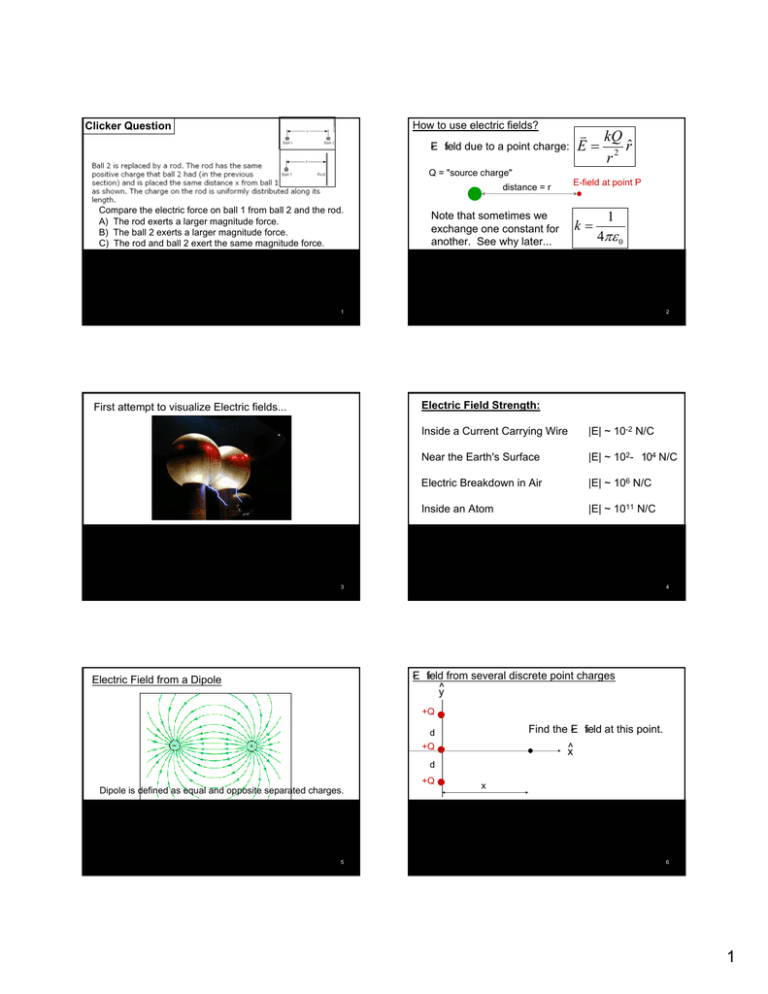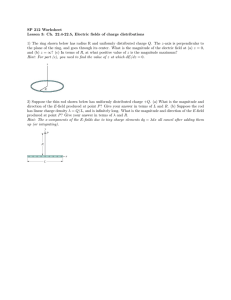r r kQ E ˆ = v
advertisement

How to use electric fields? Clicker Question - field due to a point charge: E Q = "source charge" E-field at point P distance = r Compare the electric force on ball 1 from ball 2 and the rod. A) The rod exerts a larger magnitude force. B) The ball 2 exerts a larger magnitude force. C) The rod and ball 2 exert the same magnitude force. v kQ E = 2 rˆ r Note that sometimes we exchange one constant for another. See why later... k= 1 4πε 0 1 2 Electric Field Strength: First attempt to visualize Electric fields... Inside a Current Carrying Wire |E| ~ 10-2 N/C Near the Earth's Surface |E| ~ 102- 104 N/C Electric Breakdown in Air |E| ~ 106 N/C Inside an Atom |E| ~ 1011 N/C 3 4 - field from several discrete point charges E y^ Electric Field from a Dipole +Q Find the E - field at this point. d +Q x^ d Dipole is defined as equal and opposite separated charges. 5 +Q x 6 1 Clicker Question y +Q Clicker Question If we move this point P very far away (x very large), we expect the E-field strength to approach... d +Q x^ d +Q x Ball 2 has charge Q. Ball 2 is torn apart into a rod of 10 smaller balls each with charge Q/10. A) |E| = kQ/x2 B) |E| = 3kQ/x2 C) |E| = kQ/x D) |E| = 0 E) |E| = kQ Compare the electric force on ball 1 from ball 2 and the rod. A) The rod exerts a larger magnitude force. B) The ball 2 exerts a larger magnitude force. C) The rod and ball 2 exert the same magnitude force. 7 Clicker Question +Q What is the E-field at point P? - Q s 8 Clicker Question +2Q A) |E| = 2kQ / s2 What is the E-field at point P? - Q s A) |E| = 2kQ / s2 B) |E| = sqrt(2) kQ / s2 s s P B) |E| = sqrt(2) kQ / s2 s C) |E| = kQ / ( sqrt(2) s)2 s P D) zero - Q s +Q C) |E| = kQ / ( sqrt(2) s)2 D) zero - Q E) none of the above s +Q E) none of the above 9 In the previous question, what is the accelerator of an electron if placed at point P? 10 Electric Field from a Continuous Distribution of Charge v v Enet = ∑ Ei We need some numbers... Q = 5.0 pC (picoCoulombs) = 5.0 x 10-12 C s = 1.0 mm = 1.0 x 10-3 m k = 9 x 109 Nm2/C2 me = 9.1 x 10-31 kg i dq dE |E| = 2kQ / s2 = 9 x 104 N/C |F| = q x |E| = e x 9 x 104 N/C = 1.4 x 10-14 N |a| = |F| / m = 1.6 x 1016 m/s2 !!! 11 v v kdq Enet = ∫ dE = ∫ 2 rˆ r 12 2 Clicker Question Example: Semi- Infinite Line of Charge dx x=0 charge = dq=λdx ++++++++++++++++++++++++++++++ x^ x=d What is the Electric Field at x=0? Work out on the board. 13 Clicker Question 14 MasteringPhysics comment on Significant Figures In 1897, the Indiana House Bill #246 was passed legislating the value of π should equal exactly 3. If we knew the diameter of a particular circle was 6.0 meters (and only to two significant figures), would the Indiana Bill #246 make a difference in our calculation of the circle's circumference? A) Yes, it does matter. B) No, it does not matter. C) There is no way to determine the answer. 15 16 kdQ dE z = 2 cos θ = r Ring of charge By symmetry, all -E field contributions in ^x and y^ cancel. ^ Only non - zero E - field is along z. ( h 2 2 2 R 2 + h 2 R + h kdQ ) khdQ dE z = R 2 + h2 3/ 2 ( v dE z =| E | cos θ ) Now integrate the contributions around the ring. 17 18 3 khdQ kh = E z = ∫ dE z = ∫ R 2 + h2 3/ 2 R 2 + h2 ( khQ Ez = R2 + h2 ( ) 3/ 2 ) ( dQ 3/ 2 ∫ Clicker Question ) Electric field a distance h above a ring. 19 20 How about the E - field from an infinite plane of charge? Before our ring was one dimensional. Charge density λ = [C/m] Now a good calculation trick is to integrate a whole set of rings out to infinity. Now consider ring with infinitesimal width dr. Thus the inner radius is r and the outer radius is r + dr. Area = (2πr) dr If the charge = dq, then η = dq / (2πrdr) Charge density η = [C/m2] 21 Clicker Question Each ring creates an E - field. A charge Q is spread uniformly on a rectangle of sides a and b. The original rectangle (#1) is then broken into smaller rectangles (#2 and #3). What is correct about the surface charge densities (η1,η2,η3)? b #1 a b #2 1/3a 22 #3 2/3a A) η1 = η2 = η3 B) η2 = 1/3η1, η3=2/3η1 C) η2 = 3η1, η3=3/2η1 D) none of the above 23 kh(dq) kh(2πrdrη ) = dE z = r 2 + h2 3/ 2 r 2 + h2 3/ 2 ( ) ( ) Then we need to integrate over all rings from r = 0 to r = infinity to make our infinite plane. 24 4 ∞ kh(2πrdrη ) rdr = 2πkhη E z = ∫ dE z = ∫ ∫ 2 2 r 2 + h2 3/ 2 0 0 r +h ∞ ( ) ( ) 3/ 2 Ez = η 2ε 0 Ez z You should know how to do such integrals. Try u=r2+h2. −1 E z = 2πkhη 2 2 r +h infinity = 2πkη = 0 The electric field strength is independent of the distance from the infinite plane of charge! No real plane is infinite, but this calculation is quite good when z << extent of the plane. η 2ε 0 25 26 Two Finite Charged Planes are used to accelerate charged particles. J.J. Thompson - 1897 27 5





